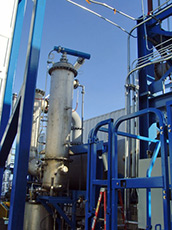Syngas: burning trash and creating energy- updated article
Feb 19
Continued research and actual implementation of syngas installations are proving to be an incredible benefit. Eliminating waste in an environmentally clean method while producing energy is a dual ‘win’. Where is syngas being used and how much energy does it produce?

Syngas is the name for a synthetic gas, which is produced via the gasification of biomass. The word biomass refers to a wide range of solids that can be burnt to produce energy, such as waste feedstock and garbage. Syngas is typically made up of hydrogen, carbon monoxide as well as carbon dioxide and methane in small amounts.
Gasification changes any carbon based matter into a synthetic gas, which is then used to generate power. Waste feedstock is a common material used for gasification. They are placed into the gasifier, which is an oxygen-starved environment, and the feedstock then syngas is produced. An enormous amount of heat required is required to produced syngas – up to 2500 degrees Celsius. Typically, the heating is produced by a process called direct heating, in which a small quantity of oxygen is added to the reactor.
What is the benefit of syngas?
Syngas is a gas which is much cleaner than those produced through burning fossil fuels such as coal and gas. In an age when emissions reduction is an important policy of many governments, and when many countries are legally obliged to reduce their carbon dioxide emissions, syngas technology has enormous potential. Syngas can be manufactured domestically, reducing dependence on foreign countries for fossil fuels.
In addition, this would generate jobs and growth in local economies. A further advantage of this technology is that syngas can be generated as part of the waste to energy process, which means that waste that would otherwise end up in the landfill gets dealt with cleanly and efficiently.
Are Syngas being practically applied today?
Absolutely. A great example can be found in New Bedford, Massachusetts, where the renewable energy company Ze-gen has run a demonstration facility for more than two years. The company injects biomass, which in this case is organic waste from municipal sources, and burns it to produce syngas. These syngas are much cleaner than gas produced from the gasification of coal, and they release much les carbon dioxide. The toxins that are produced either sink to the bottom of the chamber or are caught at the top in silica crust.
This test facility burns 1 ton of waste per hour, and in the US, where landfills are overflowing, the company has attracted considerable attention from investors. Last year, it was announced that they are planning to open a commercial and industrial facility in 2012. The future looks bright for syngas technology!
For more information, go to:
en.wikipedia.org,
biofuel.org.uk
Related Posts
- Waste to Energy pollution reduction programs to be implemented across Canada.
- Alternative Methods of Recycling Municipal Waste
- Alternative Methods of Recycling Municipal Waste – Updated Article With Extra Information
- Converting Municipal Waste to Renewable Energy Source
- Floating Pacific Garbage Patch: Threat or Energy opportunity?
6 Responses to “Syngas: burning trash and creating energy- updated article”
Leave a Reply
You must be logged in to post a comment.





Im going to tell you now, I think im adding you to my favorite writers list. This is such a great post and really hit the nail on the head for me. Please continue. Your readers need you.
August 26th, 2010 at 5:37 amThere is certainly certainly a good deal to understand about this. I consider you designed some excellent details in Features also.
July 31st, 2010 at 9:28 amgeneration of syngas is a basic way to save the our source of natural gas from depletion
April 18th, 2009 at 11:26 amI think that using Syngas is a great alternative to using fossil fuels! If utilized it would minimize the expenditure of a lot of economies, not to mention reduce the amount of pollutant emissions greatly. Thank you for this very informative essay.
March 7th, 2009 at 1:57 pmBy using Syngas as a form of synthetic gas we are going to save many of our resources and reduce our landfills? This sounds like a great way to recycle things instead of tossing them in a landfill. Not to mention that we will stop burning through so many of our precious resources.
January 9th, 2009 at 4:57 amWe are pyrolizing a variety of waste materials, including carpet scrap, sewage sludge, manure, wood waste, garbage and trash, auto shredder residue and food waste. The syngas produced from “slow pyrolysis” consists mainly of methane, ethane, propane and butane and can be used directly after minor cleanup to fire internal combustion engines which run generators. Depending on the fuel source, liquid oils are also produced which most resemble transportation fuels and bunker oil. And the char remaining after pyrolysis is mostly fixed carbon, which holds water and enriches soils. This process is carbon negative and we are producing 1 MW of power output for each 10.7 tons of plastics, 24.3 tons of manures, sewage sludges or other organic wastes.
Our first project will produce 2 MW ofpower for a municipal utility. Other projects could reach as much as 140 MW.
December 20th, 2008 at 12:54 am